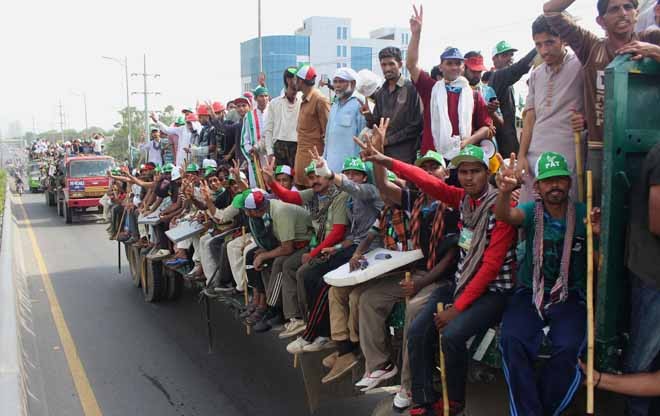
Imran’s chivalric do or die approach may still find buyers in his fan club but it is likely to drive away the pragmatic leaders

Imran Khan’s siege of Islamabad may not succeed in achieving it intended high goals but there is little doubt it will change the political scene; sadly in the case of Punjab the change seems to be for worse.
The country at large has not paid heed to the call for the revolution or Azaadi and has maintained a distance from ‘the politics of GT Road’. The Azaadi march spectacle, however, will travel along all other roads and have a wider impact.
Pakistan Tehreek-e-Insaf’s popular support base is clearly divided into two main sections. One is Khan’s awe-struck fan club and the second is the brigade of pragmatic conventional leaders who joined the PTI bandwagon after its landmark December 2011 rally in Lahore.
The march has visibly shaken both of them. The core of the fan club is now ‘dharna-hardened’ but the more suave among them haggle to defend the latest party actions, and a good number has either chosen to denounce their affiliation or has gone into a silent mode. This thinning out of its youth ranks can damage the party’s standing in the metropolises of Lahore and Karachi. But these assertions are based on anecdotal evidences, and the reactions of supporters might prove to be momentary.
The pragmatic electables, however, will become a bigger headache for the party. They provided the PTI the electoral stature it currently stands on. A major test is just days away. The opposition in Khyber Pakhtunkhwa Assembly has already submitted a no-confidence motion. A failure here will have a domino effect on the party’s ranks of hurriedly recruited electables. There was audible bickering on their part when Khan announced resignations from the assemblies, except that of KPK.
PTI polled the highest number of votes, around one million votes or 19.4 per cent in KPK assembly elections and its seat tally currently stands at 56 in the 124-member house. The party’s KPK votes, however, are just 16 per cent of its total votes as a whopping 75 per cent were piled in by Punjab.
The party polled five million or 18 per cent of the valid votes in Punjab Assembly elections that won it just 29 of 371 seats while PML-N polling 41 per cent votes is occupying 312 seats. The disparity in seats and votes is typical of the first past the post election system.
In recent Indian elections, BJP surpassed the majority mark and formed the strongest government since 1984 while securing just 31 per cent of the total polled votes. The total vote percentage of the PTI and its allies in KPK, too, is close to 30 per cent in the province.
PTI’s numbers in Punjab Assembly are frustratingly low. Numerically, the Opposition stands nowhere. Hardly anyone knows the name of the opposition leader. The party cannot possibly scuttle the Punjab government on any front. But that’s the glass half empty; PTI also has the glass half full, which it is not only refusing to acknowledge but is bent upon spilling it.
PTI has the second biggest share in Punjab’s votes and that certainly is no small feat. Its 6.3 million votes make it a strong and legitimate opposition in the provincial politics. If it could objectively analyse its weaknesses and strengths and have a futuristic approach, it could easily compensate for its present low numbers in the house. Its current maximalist politics, however, is likely to shrink it into a minnow and that will leave only one player in Punjab’s political arena, the PML-N.
Votes in Punjab were evenly spread among PML-N, PPP, and PML-Q in 2008 elections with each having a 27 to 28 per cent share. The equilateral triangle flattened to a skewed equation in 2013 between PML-N and the new comer PTI. PPP lost 3 to 5.5 million votes and PML-Q was shorn of 4.4 of its 5.8 million votes. The loss of these two parties became the booty for the PML-N and the PTI.
PTI’s decision to accept electables in its ranks was a major shift from its earlier puritanical stand of never allowing entry to the old hand ‘corrupt’ politicians. It anyways swelled its ranks. But the more experienced Nawaz League displayed a better mastery at manoeuvering the political class of Punjab. The party was able to ensure them that power was just round the corner. Its government in Punjab helped boost its image and it was able to attract and retain the top power contenders in its ranks.
Let us not fall for notions like ideology and party loyalty. All that matters in currnent politics is power or an assurance of access to power. Groups of electors participate in politics through self-appointed ‘collective bargaining agents’ whose success depends on their ability to correctly predict the winning horse.
Barring a few, the PTI was joined by the second line of power players who thought that using non-conventional ‘revolutionary’ jargon will lift their chances, and it did do the trick for them as the performance of many surprisingly exceeded expectations. But it fell short of being a miracle.
The PTI did not attempt to replace or revamp the traditional political practices, it just wrapped these in the rhetoric that appeals its other constituency, the educated youth.
The PTI’s long march has taken its rhetoric of change way too far. Imran’s chivalric do or die approach may still find buyers in his fan club but it is likely to drive away the pragmatic leaders that have actually founded his present electoral stature.
Since these leaders are the second tier of political elite, they can wait for their day but their association with the party hinges on how well the party manages to cover the distance between an opposition party and a ruling party, and this is surely not the distance that Khan has travelled on the GT Road.